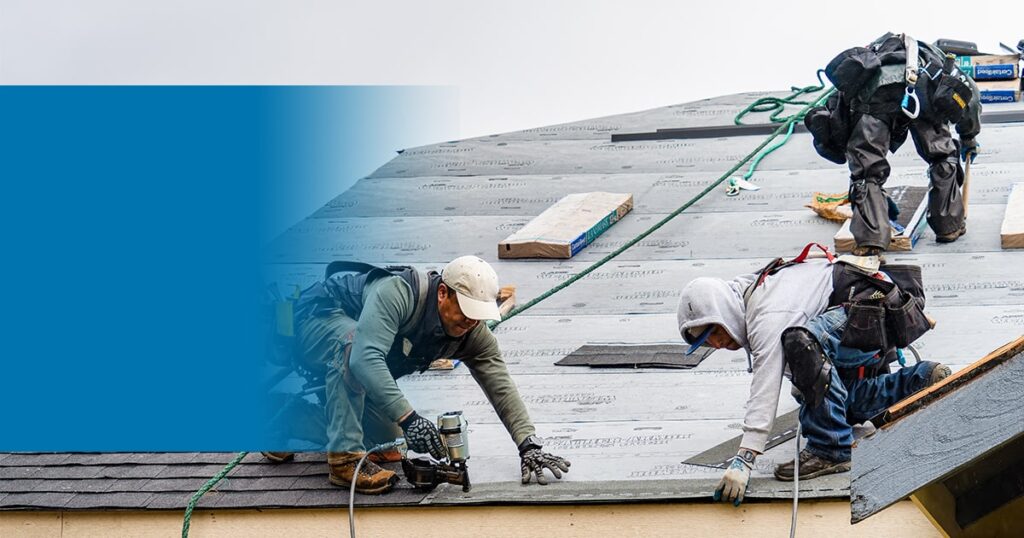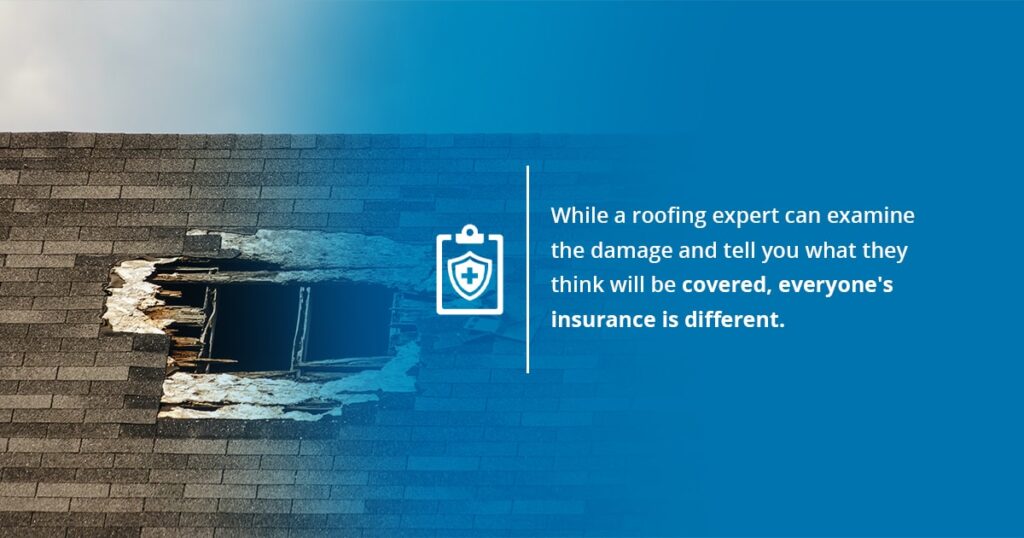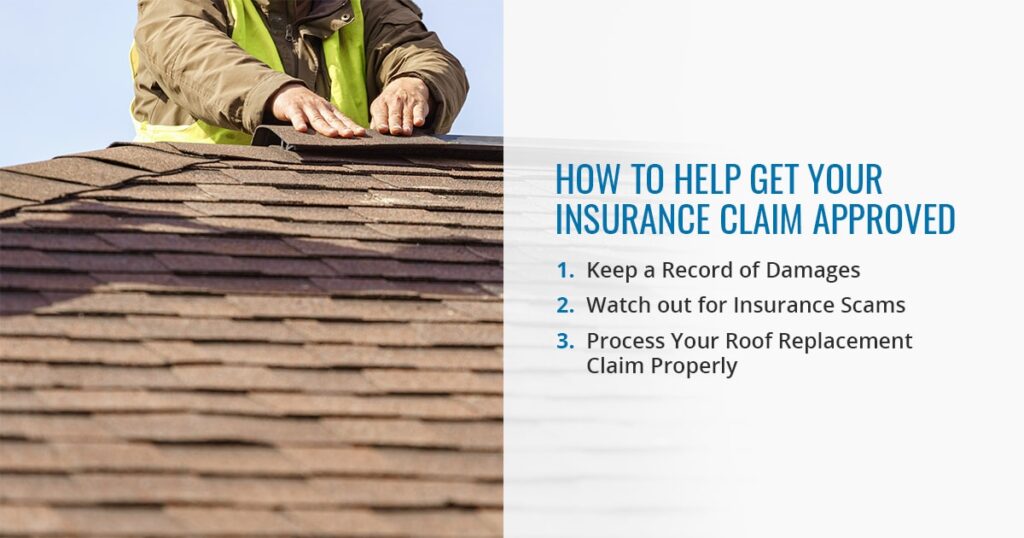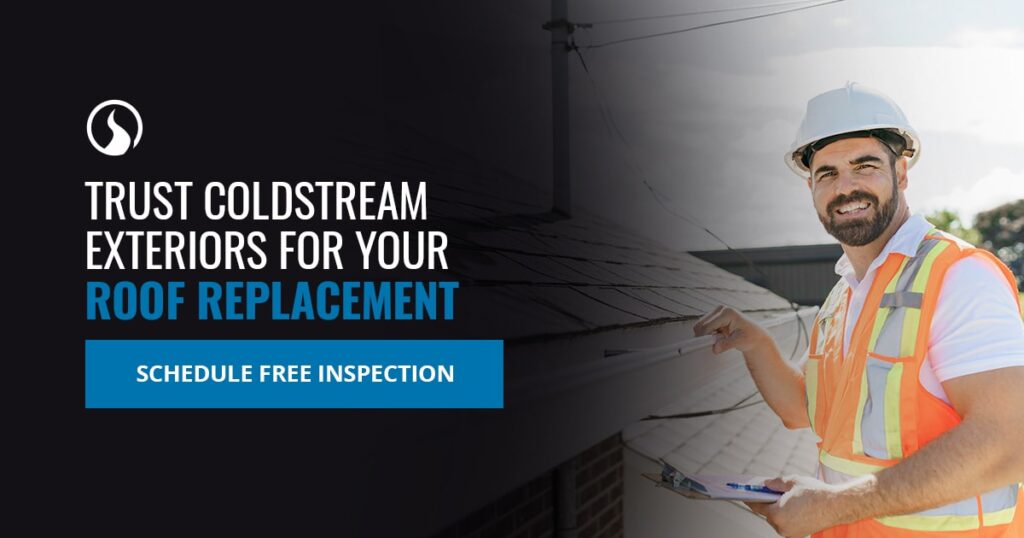Will Your Insurance Cover Your Roof Repair or Replacement?

If you’ve found yourself with roof damage, you might be confused about the insurance process. Filing a claim can be a significant headache, especially if you’ve never done it before. Unfortunately, almost every homeowner will have to deal with a home insurance claim at some point.
Roofs take on a lot of wear — they protect us year-round from harsh weather and last for decades. However, a sudden storm can lead to surprise damage. Your homeowners insurance is there to help you out, but how do you get insurance to pay for a roof replacement?
Let’s go over the basics of roof coverage and the process of filing an insurance claim. When it’s all said and done, you’ll be able to get your roof evaluated and claim filed so that you can get a brand-new, durable roof to cover it for years to come.
Roof Replacement vs. Repair
Figuring out if you need a roof repair or replacement is your first step in evaluating and fixing any damage done to your home. Before thinking about filing an insurance claim, contact a roofer for an inspection and estimate. They’ll evaluate your roof damage and let you know what needs to be done to restore the structure.
You might not even need a complete replacement — some damage can be fixed with a simple repair. This has the added benefit of being less expensive than a total replacement. Some homeowners insurance covers repairs and replacements, depending on the extent of the damage and what caused it.
Without a professional evaluation, you have no idea what the extent of the damage is. Additionally, your insurance will send an adjuster to evaluate the damage. They might not do as thorough an evaluation as a roofing contractor and could potentially write you off for replacement incorrectly.

What Does Insurance Cover?
If you’re dealing with roof damage, you’ll probably contact your insurance company at some point to find out what they’re willing to cover. While a roofing expert can examine the damage and tell you what they think will be covered, everyone’s insurance is different.
Your insurance is more likely to cover a complete roof replacement if your roof is 10 years old or newer. This is because the average shingle roof lasts around 20 years — after 10, you start to see more wear and tear. Insurance companies only want to pay for unexpected replacements, so they avoid the risk of replacing a worn, older roof. The older your roof is, the more likely it is that it has hidden, pre-existing damage insurance won’t pay for.
Your policy will tell you what kind of coverage you pay for. Depending on your coverage, your insurance will cover varying degrees of roof damage. There are typically two types of rood damage you could have, and your insurance company will decide which category your issue falls into:
1. Wear and Tear
This is damage due to a roof’s age, lack of maintenance or a failing structure. Insurance companies won’t usually cover repairs or replacements in these instances. Roofs over 20 years old or with poorly maintained structures are less likely to be covered by insurance due to preexisting damage. This is why preventative maintenance and professional inspections are essential — they both keep your roof in good condition and increase its chances of getting covered by insurance.
2. Damage Due to Covered Loss
This category covers damages that happen due to a covered loss like wind, fire, rain, hail, snow or falling tree branches. Your homeowners policy will lay out precisely what losses it covers, but it’ll typically cover damage caused by common outside factors. Insurance policies don’t cover preexisting damage — if you have preexisting damage that worsens due to a covered loss, it could affect your coverage.
Roof Insurance FAQs
Let’s review some common insurance roof replacement questions and their answers to help determine if insurance covers your issue.
1. How Often Will Insurance Pay for a New Roof?
Your insurance company will evaluate your claim and pay for the cost of a new roof as long as your plan covers the damage and cost. If your roof meets your policy requirements, you could get the damage covered entirely by your insurance company.
Your policy will show exactly how much damage your insurance will cover and how often. Your policy might have different stipulations around damage, cost and replacement frequency based on what your pay for it. Go over your policy to find out if there’s a limit on the number of times you can get a roof replacement, how much your insurance will cover and what other qualifications you have to meet.
2. Does Homeowners Insurance Cover Roof Leaks From Rain?
Your insurance will probably cover roof leaks from rain. However, the damage must be accidental and sudden for your insurance to cover it. Your roof replacement coverage only applies when damage occurs to a roof that was previously strong and undamaged.
3. Does Home Insurance Cover Roof Damage From Wind?
Yes, homeowner’s insurance usually covers wind damage to your roof. This can include wind damage to the siding, shingles, chimney, granules, soffit and fascia. If the wind caused a leak to occur, your insurance should cover that, too.
You can prove wind damage to your roof by getting a roofing inspection from a roofing company. They’ll take pictures and write up a report of the damage they find. Combining this with other proof of high winds like weather reports will prove to your insurance company that wind caused your roof damage. Always submit pictures along with the roofing expert’s written report to back up your claim with solid evidence and make your claim more likely to get approved.
4. Does Insurance Cover Blown Shingles?
Insurance will cover blown shingles as long as they were caused suddenly and accidentally and your coverage limit is high enough. Blown shingles will usually fall under the “wind damage” category of your policy — so long as you have wind damage under your coverage, you should be able to get shingle replacements.
5. Is a Roof Covered by Building Insurance?
Building insurance covers the structures of your home, like your walls, floors and roof. This coverage should also extend to your roof.

What Isn’t Covered by Insurance?
Your policy will list out all the different covered damages — or perils — you pay to have protected. While many perils will be covered under your insurance policy, others aren’t. Some perils that won’t be under a basic policy include the following:
- Earthquakes: Earth movements like sinkholes and earthquakes are often not covered by insurance. If you want these covered, you’ll have to purchase an addendum for an additional fee.
- Insects and animals: Damage from termites, rodents, birds and insects isn’t usually covered. You’ll probably end up paying to correct these problems out of pocket.
- Smoke: If agricultural or industrial operations cause smoke or smog damage to your home, insurance won’t cover it.
- Water: While nature-related water damage is often covered, other types of water damage are not. Flood insurance must be purchased separately through the FEMA-managed National Flood Insurance Program. Additionally, any backups or overflows from your drains, sump pumps or sewer system probably won’t have coverage. Most homeowners need to purchase an addendum — also called an endorsement — to cover these perils.
- Preexisting damage: If you already have roof damage to your home prior to the event you need coverage for, your claim might be denied. This is why it’s vital to get a professional to inspect and look for signs of roof damage. If you have a record of an up-to-date inspection, your insurance will be less likely to deny your claim based on preexisting damages.
- General wear and tear: Regular wear issues won’t be covered under insurance, either. Weather like wind, snow and rain all put pressure and strain on your roof. Getting regular maintenance will help prevent these issues, so they don’t cause severe damage down the line. If your insurance company determines your roof damage was caused by wear and tear or lack of maintenance, you won’t get a claim approval.

How to Help Get Your Insurance Claim Approved
While there’s no guarantee your insurance will cover your roof repairs or replacement, there are steps you can take to help improve your chances. The more diligent you are about records, scammers and your policy, the more likely you are to be successful. Review your policy in detail, and always work with a reputable roofing company to help protect your home.
Here are some tips to help you get your claim approved:
1. Keep a Record of Damages
You should have a written record of any damages and repairs on your roof. Additionally, any maintenance and inspections should be recorded. Having a paper trail proving you maintain your roof and there’s no preexisting damage will help you file a successful claim with your insurance company. A lack of records shows you haven’t been maintaining your roof, and your claim might be denied if the insurance company finds that preexisting issues caused damage.
2. Watch out for Insurance Scams
When severe storms or weather events occur in an area, untrustworthy contractors will set up short-term contracting scams to trick homeowners out of their money. They’ll establish themselves in an area, offer to fix up your roof, do a poor job and then leave town. Homeowners then realize they’ve been scammed.
To help prevent this, always conduct research on your contractor. Look for well-established companies with a history of quality work in your area. Never pay for your roof work in cash, and get a signed contract before any work is done on your home. A professional, reputable contractor will have no problem with these steps, but scammers will.
You should also have your insurance adjuster and a trustworthy contractor evaluate your roof. A contractor will tell you if you need to contact the insurance company for a full roof replacement and determine whether you only need a simple repair. Getting multiple opinions will help you evaluate all your options.
Along with roofing scams, some less-than-honest contractors will push for you to file a claim but will have you sign the right to file the claim over to them. These contractors will then file fraudulent damage claims and proceed to sue the insurance company when they refuse the claim. Eventually, insurance companies settle with the contractor for high sums without you, the homeowner, ever knowing about it.
Always talk to a well-reviewed roofing company before filing a claim or signing any insurance claim paperwork. This protects you from scams and ensures you have damage documentation before you call your insurance company.
3. Process Your Roof Replacement Claim Properly
Once you’ve gotten a contractor to inspect your roof and document its state, it’s time to make your claim through the insurance company. They’ll send an adjuster out and provide you with an estimate. Once the estimate and funds are issued, your contractor will begin the job — they’ll provide you with a timeframe estimate and go over all the work with you beforehand. Once the work is complete, you or the insurance company will pay the contractor based on the estimate.
Don’t wait too long to get your claim filed, as many policies have a stipulation about time. If you file your claim too late, the company might reject it for not arriving in the designated amount of time. While you should do your research with contractors, try to get a thorough roof inspection done as soon as possible to avoid missing the claim-filing window.
It’ll be much easier to get your claim processed with proper documentation. If you have all the records and a contractor’s documentation of the recent damage, your insurance company should help you out based on your coverage. If your claim is denied, you can file an appeal.
Request a re-inspection of the roof and ensure you have a reputable roofer there when the adjuster performs the re-inspection. This will ensure the adjuster completely and thoroughly reevaluates the condition of your roof, improving your chances of successfully appealing.

Trust Coldstream Exteriors for Your Roof Replacement
Whether you need a roof repair or roof replacement, Coldstream Exteriors has you covered. We’ll evaluate your roof damage and help you understand your next steps. With years of experience servicing the greater Tampa, Cincinnati and St. Louis areas, we’re an established and trustworthy roofing company to work with. We offer industry-leading warranties for our customers, helping protect you even more when paired with your homeowners insurance.
Our experienced roofers will inspect your roof, estimate the repair costs and work with you to find the best payment plan for your budget. Whether your insurance claim is denied or you want a simple roof repair instead of replacement, we offer 0% and low-interest financing to help you restore your home. We’re A+ rated by the Better Business Bureau and have a reputation for high-quality roof work and customer service.
If you need roof services, contact us to schedule a free inspection today.
